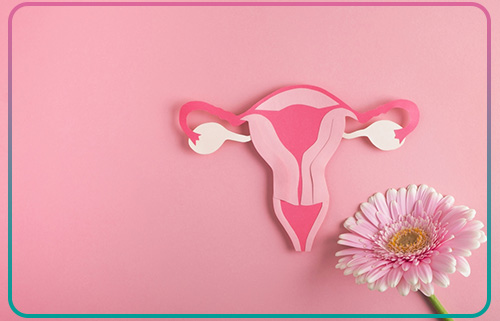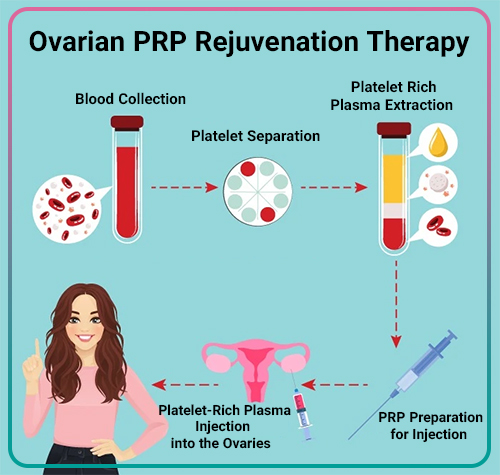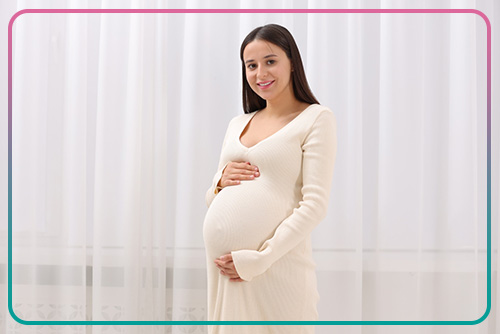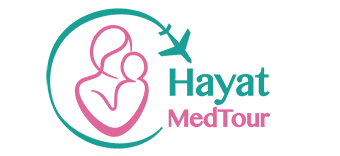Ovarian PRP treatment is a novel and promising method in the field of infertility. Infertility affects 1 in 6 people, placing emotional strain not only on the individual but on the entire family. This issue can stem from various causes, with Premature Ovarian Failure (POF) and diminished ovarian reserve (DOR) being among the primary factors.
In such cases, many doctors recommend IVF with Egg Donation. However, due to ethical, cultural, or personal limitations, this option is not acceptable for everyone. This is where the injection of Platelet-Rich Plasma (PRP) into the ovaries emerges as an alternative treatment to rejuvenate the ovaries and improve egg quality. This procedure utilizes the growth factors from the patient’s own blood to revitalize the ovaries and enhance fertility.
In recent years, Iran has become a popular destination for patients seeking this treatment, thanks to its extensive research in infertility, including ovarian PRP, as well as its provision of high-quality and cost-effective medical services. If you want to learn more about the benefits, eligibility criteria, and other details of ovarian PRP injection in Iran, read on.
Understanding Ovarian PRP: The Scientific Rationale

Platelet-rich plasma (PRP) injections represent an emerging treatment designed to enhance ovarian function and improve the likelihood of pregnancy. This minimally invasive procedure involves the direct injection of a concentration of the patient’s own platelets into the ovarian tissue.
To understand the mechanism, it’s important to first define the components. Plasma is the liquid matrix of blood, primarily composed of water and proteins, which serves as the medium for transporting red blood cells, white blood cells, and platelets. Platelets are specialized cells best known for their role in blood clotting, but they are also critical for tissue repair and regeneration. They achieve this by releasing a potent cocktail of cytokines and growth factors upon activation.
For years, the regenerative properties of PRP therapy have been utilized in diverse medical fields, from orthopedics to dermatology, to reduce arthritis pain, treat hair loss, and accelerate post-surgical healing. Its therapeutic power lies in its high concentration of growth factors, which are instrumental in stimulating cell proliferation, promoting angiogenesis (the formation of new blood vessels), and reducing inflammation.
More recently, PRP has been applied to the field of reproductive medicine. The primary objective of ovarian PRP is to rejuvenate the ovarian environment, stimulate dormant follicles, and enhance oocyte (egg) quality. This treatment is particularly considered for women, typically aged 35 to 42, experiencing a natural decline in fertility or those diagnosed with diminished ovarian reserve (DOR). For these patients, PRP therapy may offer a chance to increase the likelihood of natural conception or to improve the quality of eggs retrieved for subsequent In Vitro Fertilization (IVF) cycles.
Preparation before ovarian PRP treatment
To increase the effectiveness of the treatment and prevent possible complications, it is recommended to observe the following points:
- Stop taking oral corticosteroids (for example, prednisone) with the advice of a doctor 2 weeks before PRP.
- Avoid taking over-the-counter blood thinners such as aspirin one week before PRP. Note that prescription anticoagulants such as warfarin should be stopped with the advice of a doctor.
- Stop taking supplements containing garlic, ginkgo, ginseng, green tea, vitamin E, omega-3, and fish oil one week before PRP. Because they increase the risk of bruising.
- Fast for 6 to 8 hours before anesthesia. Your last meal should be light and low-fat.
- Be sure to take a shower before visiting the clinic.
The Ovarian PRP Procedure: A Step-by-Step Guide
Before the procedure, you will undergo a comprehensive pre-treatment evaluation. Your doctor will assess your ovarian health and overall medical condition to determine if you are a suitable candidate for ovarian PRP. This therapy is typically most effective for women under 42 and is generally not recommended for those with established premature menopause or very small ovaries.

If you are deemed an eligible candidate, the ovarian PRP procedure will be performed in the following steps:
Step 1: Blood Collection
The process begins with a simple blood draw, similar to a routine blood test. Approximately 30 milliliters of blood will be collected from your arm.
Step 2: Plasma Separation
Your blood sample is then placed into a specialized centrifuge. This device spins the blood at high speed, using centrifugal force to separate its components. This process isolates and concentrates the platelets, creating the platelet-rich plasma (PRP) while removing red and white blood cells. The resulting PRP is now prepared for the injection.
Step 3: Anesthesia and Preparation
To ensure your comfort and minimize any discomfort or anxiety, the procedure is performed under sedation or light anesthesia. This allows you to remain relaxed and pain-free throughout the treatment. Once you are comfortably sedated, the doctor will proceed with the injection.
Step 4: Injection of Platelet-Rich Plasma
The plasma injection can be performed using two methods:
- Transvaginal Method: The plasma is injected into the ovaries using a method very similar to egg retrieval in IVF. This is done with the aid of a vaginal ultrasound and a long, thin needle.
- Laparoscopic Method: The PRP injection into the ovaries can be performed at the same time as a diagnostic or therapeutic laparoscopy. In this method, the needle is inserted into the ovary through the abdomen instead of the vagina.
Step 5: Post-Treatment Care
The ovarian PRP treatment takes about 20 to 30 minutes. After the procedure is complete, you will be moved to a recovery area and monitored for a short period. Typically, you can be discharged after about an hour. Due to the effects of the anesthetic, it is recommended that someone else accompany you to your place of accommodation.
To promote a faster healing process, it is crucial to follow these guidelines:
– Take your prescribed medications consistently and as directed.
– Carefully adhere to the post-operative instructions provided by the hospital.
– Consult your doctor about when you can resume any medications that were paused before the treatment. Additionally, discuss the need for painkillers.
– Refrain from engaging in sexual intercourse or any strenuous physical activities that may cause excessive sweating for 24 hours after the treatment.
– Avoid swimming in a pool for 48 hours following the treatment, limit your caffeine intake, and do not take supplements that may increase the risk of bruising.
– While the risk of infection is very low, contact your doctor if you notice any warning signs, such as a fever.
Benefits of Ovarian PRP: More Than Just a Treatment
Although ovarian PRP is considered a relatively new method, results show that it can be beneficial for improving ovarian function, egg quality, and ultimately, achieving high-quality embryos. Some of the most important benefits of ovarian rejuvenation with PRP include:
1. Potential to Improve Egg Quality
The primary benefit of ovarian PRP treatment is the enhancement of egg quality. The injection of platelet-rich plasma into the ovaries helps repair damaged tissues and stimulates the production of higher-quality eggs. This process improves the number of viable eggs, thereby increasing the chances of pregnancy for women with diminished ovarian reserve.
2. Increased IVF Success Rates.

For women with diminished ovarian reserve, undergoing ovarian rejuvenation with PRP before IVF can help generate a greater number of high-quality eggs. Consequently, after fertilization, more high-quality embryos are available. Therefore, ovarian PRP can contribute to the formation of top-quality embryos, thus increasing the overall success rate of the IVF cycle. It is important to note that ovarian PRP before IVF should only be performed upon the recommendation of the treating physician. Learn more about tips for increasing the chance of success in IVF: Tips for Boosting Your Chance of IVF Success
3. Pregnancy at an older age
As many women today postpone marriage and childbearing until later in life, the prevalence of infertility is increasing worldwide. As we age, ovarian reserve decreases, and the quality of eggs is affected. This problem is more severe in women with low ovarian reserve and reduces the chances of pregnancy, even despite the use of assisted reproductive techniques. PRP injections into the ovaries can increase the chances of pregnancy over the age of 35 by helping to produce high-quality eggs.
4. Ovarian regeneration
Decreased ovarian function often leads a person to use donated eggs (Learn more about IVF with donor eggs in Iran). However, platelet-rich plasma can improve ovarian function by stimulating the growth of healthy tissue and increasing the chances of a successful pregnancy.
5. Fewer Complications and Higher Safety
Because the plasma injected into the ovary is derived from the individual’s own blood, the risk of allergic reactions or disease transmission is minimal. Furthermore, the plasma injection process does not require hospitalization, and the recovery time is very short. As a result, individuals can enhance their chances of becoming pregnant either naturally or through assisted reproductive methods without encountering serious complications.
Success Rate and Realistic Expectations
Ovarian PRP is a relatively new treatment, and more research is needed to confirm its efficacy and identify suitable candidates. Although this method can, in some cases, help increase Anti-Müllerian Hormone (AMH) levels and improve egg quality, it should not be considered a definitive solution for female infertility.
In a study conducted in Iran, the effect of PRP injection into the ovaries on the fertility status of infertile women was investigated. In this research, 50 women with a mean age of 39 (range 35-43) who had an average infertility history of approximately 4 years (range 2-6 years) were studied.
The results showed that after ovarian PRP treatment, FSH levels decreased, while AMH levels, the number of high-quality eggs, and the number of high-quality embryos increased. However, only the increase in the number of high-quality embryos was statistically significant.
If you are looking for a way to increase your chances of getting pregnant, you can use Ovarian PRP in Iran as a complementary method alongside IVF or other assisted reproductive treatments. However, it is important to be realistic and not expect miraculous results from this method alone.
Key Factors for the Success of Ovarian PRP
PRP can be beneficial in improving ovarian function, but its success depends on several important factors, including:
- The patient’s age
- The state of ovarian reserve and the severity of its decline
- The patient’s general health
- The experience and skill of the physician
Ovarian PRP is a promising method for enhancing fertility, but it is not suitable for everyone and can be challenging in some cases. Before proceeding, you need to be carefully evaluated by a fertility specialist to determine if you are a good candidate for this procedure.
Since everyone responds differently to PRP, as with any medical intervention, you may need multiple treatment sessions to achieve the desired results.
Why Choose Iran for Ovarian PRP Treatment?

As a hub for health tourism and infertility treatment in the region, Iran has been hosting infertile couples from all over the world for years. The presence of experienced doctors and advanced IVF centers in Iran has led many people to travel to this country to fulfill their dream of having children. Other benefits of Ovarian PRP Treatment in Iran include:
1. Affordability of Treatment
The cost of ovarian PRP (Platelet-Rich Plasma) treatment can vary based on the hospital or treatment center, the doctor’s fees, and any necessary tests. However, the expense for this procedure in Iran is considerably lower than in the United States, European countries, and even some neighboring countries. For instance, the complete range of services in Iran costs approximately $1,500 to $2,000. In contrast, these same services can cost around €1,500 in Turkey and $3,000 in the UAE. When you compare these prices to the high quality of services and the extensive experience of Iranian doctors, it is clear that Iran is an economical and safe option for ovarian PRP treatment.
2. High quality of medical care
Although the cost of ovarian PRP treatment in Iran is lower than in many countries, this does not mean a reduction in the quality of services. Iranian infertility centers always strive to provide the best services and facilities to patients by adhering to the highest medical standards, using advanced equipment, and utilizing experienced doctors.
In Iran, combining ovarian PRP with IVF offers a comprehensive treatment approach to solving fertility problems that has an acceptable success rate. Treatment plans are also designed individually to achieve the best possible results.
3. Emotional Support
In Iran, infertility clinics provide compassionate care and personalized treatment plans to help infertile couples who have tried various methods but have not yet achieved success navigate the treatment process with more peace and confidence. Iranian specialists accompany patients throughout all stages of treatment and provide guidance and support in the face of any challenges.
4. Logistics and Services
In addition to providing medical care, Iranian infertility clinics offer a range of support services for international patients. These services include airport pick-up, assistance from experienced translators, and arrangements for suitable accommodation. This way, patients can focus on their treatment process without any concerns.
Who is an ideal candidate for ovarian PRP?
People who benefit most from this treatment include:
1. Women with diminished ovarian reserve (DOR)
Diminished ovarian reserve occurs when you have fewer eggs than other women your age. Egg counts naturally decline with age, but this process occurs earlier in some people. Diminished ovarian reserve does not mean that pregnancy is not possible; it simply indicates that getting pregnant is likely to be more difficult and will need to be achieved through assisted reproductive techniques.
Platelet-rich plasma contains over 800 proteins, cytokines, and growth factors, which can stimulate cell proliferation and differentiation, angiogenesis, and tissue regeneration. Research on people with diminished ovarian reserve has shown that injecting plasma directly into the ovaries increases the number of quality eggs extracted during IVF and improves the chances of pregnancy.
2. Women with Premature Ovarian Failure (POF)
Premature ovarian failure is a rare condition in which the ovaries stop working before the age of 40. It is associated with irregular menstruation and often leads to infertility. PRP helps some women with POF improve the function and health of their ovaries. This improvement may activate dormant follicles and bring them into the growth cycle, allowing them to release eggs.
3. Women Over 35
Today, many women are choosing to postpone marriage or pregnancy for various reasons. However, this delay can increase the risk of ovarian failure or other infertility issues when they are finally ready to conceive. Platelet-rich plasma (PRP) therapy can help enhance ovarian function in these situations and improve the chances of pregnancy, particularly for women who have not found success with other treatments.
4. Patients with repeated IVF failures
This treatment is suitable for women who have undergone several embryo transfers but have failed each time, or who do not respond to ovarian stimulation drugs to start the IVF process. PRP improves ovarian function and egg quality in these individuals, thereby increasing the chances of success of assisted reproductive treatments.
Conclusion: Taking the Next Step Toward Parenthood

Despite remarkable advances in fertility treatments, many individuals continue to face challenges even after undergoing assisted reproductive techniques such as IVF. Ovarian PRP therapy offers an innovative approach that can enhance the success rate of IVF and help overcome infertility more effectively.
Though the journey may seem daunting, with the right support and guidance, it can become a meaningful and hopeful experience. At HayatMedTour, we are dedicated to standing by your side throughout every stage of your treatment — from your first step until you achieve your ultimate goal.
To learn more about ovarian PRP therapy in Iran and its specific requirements, contact us today for a personalized consultation. Our experienced team will explain the procedure in detail and answer all your questions.
Our support could be the first step toward making your dream of parenthood a reality.
References:
Platelet-rich plasma injection into the ovaries for IVF
Frequently Asked Questions
How long does it take to see results after PRP?
Following ovarian PRP therapy, it typically takes about 2 to 3 months for the platelets to release growth factors and enhance ovarian function. The beneficial effects of PRP usually last for around three months.
If more than six months have passed since your PRP treatment, the procedure can be safely repeated before starting your next IVF cycle to help optimize your results.
Can PRP completely reverse menopause?
No. Ovarian PRP therapy cannot completely stop or reverse the menopause process. However, in some cases, it can improve egg quality and increase the chances of pregnancy in those who have recently experienced premature menopause.
What are the possible side effects and risks of ovarian PRP?
Like any treatment, ovarian PRP may have side effects. Fortunately, these effects are typically mild and temporary, including symptoms such as pain, spotting, or abdominal cramps. However, in rare cases, there is a risk of infection. In Iran, the use of advanced equipment and adherence to medical standards significantly reduce the likelihood of these side effects occurring.
How many sessions of ovarian plasma injection are required?
The number of PRP injection sessions can vary depending on each individual’s condition. In most cases, one to two sessions are sufficient. The exact number of treatments is determined by the specialist’s assessment based on your medical evaluation and response to therapy.
How can foreign couples travel to Iran for ovarian PRP treatment?
Non-Iranian couples can contact HayatMedTour’s consultants by completing the free consultation form. Once the form is submitted, Hayat’s team will handle every detail, including visa arrangements, accommodation booking, and scheduling medical appointments with a qualified doctor. Upon arrival in Iran, a dedicated interpreter will accompany the couple throughout the treatment process, ensuring comfort, clear communication, and full support.
What is the estimated cost of ovarian PRP treatment in Iran?
The estimated cost for ovarian PRP in Iran is between $1,500 and $2,000. This includes necessary tests, routine medications, a doctor’s visit, the plasma injection procedure, and accommodation.
